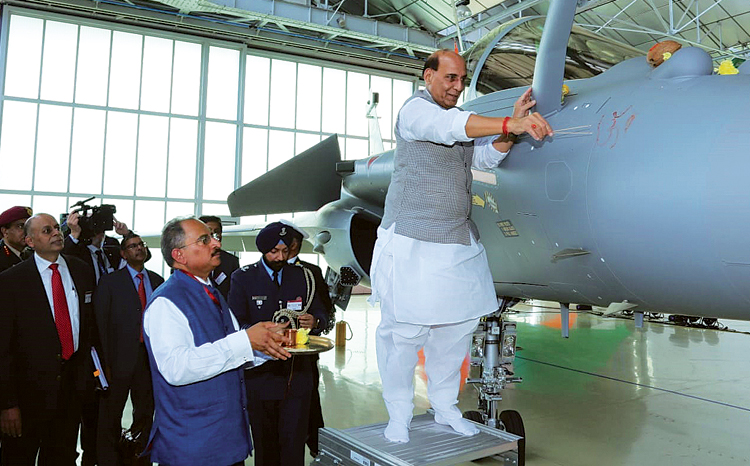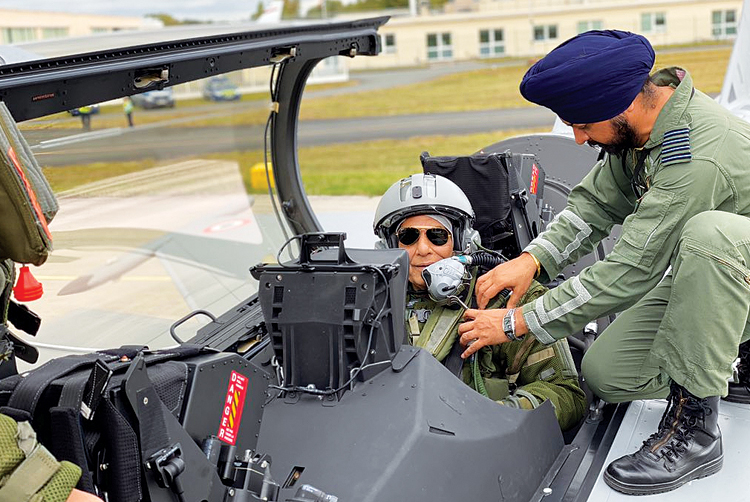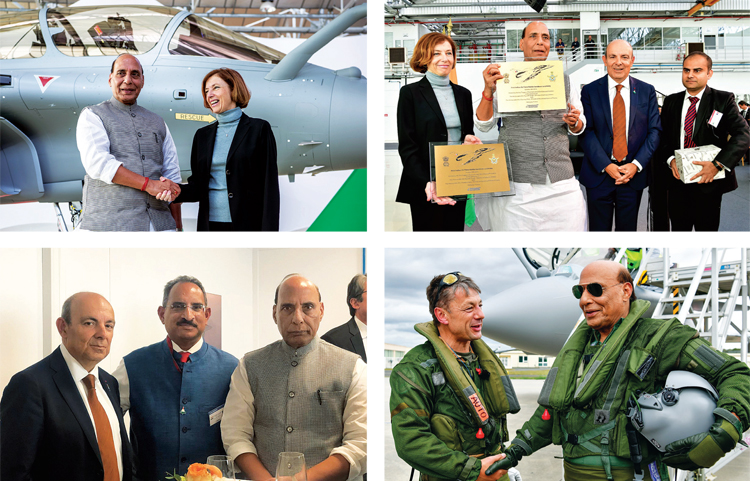INDIAN ARMED FORCES CHIEFS ON OUR RELENTLESS AND FOCUSED PUBLISHING EFFORTS

The insightful articles, inspiring narrations and analytical perspectives presented by the Editorial Team, establish an alluring connect with the reader. My compliments and best wishes to SP Guide Publications.

"Over the past 60 years, the growth of SP Guide Publications has mirrored the rising stature of Indian Navy. Its well-researched and informative magazines on Defence and Aerospace sector have served to shape an educated opinion of our military personnel, policy makers and the public alike. I wish SP's Publication team continued success, fair winds and following seas in all future endeavour!"

Since, its inception in 1964, SP Guide Publications has consistently demonstrated commitment to high-quality journalism in the aerospace and defence sectors, earning a well-deserved reputation as Asia's largest media house in this domain. I wish SP Guide Publications continued success in its pursuit of excellence.
- The layered Air Defence systems that worked superbly, the key element of Operation Sindoor
- Operation Sindoor | Day 2 DGMOs Briefing
- Operation Sindoor: Resolute yet Restrained
- India's Operation Sindoor Sends a Clear Message to Terror and the World – ‘ZERO TOLERANCE’
- Japan and India set forth a defence cooperation consultancy framework, talks on tank and jet engines
The Man @ Work
Rajnath Singh has taken political ownership of the Ministry of Defence like few of his predecessors did; such factor was on full display during the handover ceremony of Rafale in France on October 8, where he led the Indian contingent from the front.

It’s been less than five months since Rajnath Singh took over as India’s Defence Minister. But from Day One, he has taken steps which coherently convey the direction and emphasis of his Ministership.
His first step, the day after he took over political leadership of one of the largest militaries of the world, was to visit Siachen, the world’s highest battlefield, where the continuous deployment of the Indian Army since 1984 has become a symbol both of India’s resolve, and also the supreme effort made by soldiers to uphold India’s sovereignty against all odds.
The message of the Siachen visit at the start of his tenure was that those who occupy the highest office in the land stood by the foot soldier. Rajnath Singh is not the first Defence Minister to visit Siachen to show support for valiant efforts to defend India in the most inhospitable conditions. What sets him apart is the open declaration of intention to give a free hand to the military to respond to security challenges. This puts him in perfect alignment with Prime Minister Narendra Modi’s instinct to use hard power when pushed into a corner.
At the Rafale induction ceremony in France, the Defence Minister Rajnath Singh personally performing shastra puja on the IAF’s first Rafale fighter could be one of the most defining images of his ministership
After his Siachen visit, Rajnath Singh made his next splash with the public declaration that India’s Nuclear Weapons Policy of No First Use was not cast in stone. Seen in the context of the frequent nuclear sabre rattling by Pakistan in order to firewall itself from conventional military retaliation by India for openly waging a proxy war in Kashmir, this was an important statement that India would not be deterred by traditional positions and postures nor held back by nuclear blackmail. More importantly, it conveyed an end to India’s culture of hesitation in wielding its most destructive weapons and its willingness to use these in a situation which threatened its survival.

All this is enabled by the Modi approach but Rajnath Singh’s Defence Ministership also marks the mainstreaming of military power in Indian political discourse. Earlier, the initiative for the use of military matters in political appeals was restricted to the level of Prime Ministers, as in the case of Indira Gandhi, Atal Bihari Vajpayee and Narendra Modi himself post the paradign shifting cross-border air strike at Balakot in Pakistan in the run up to general elections in May this year.
The Defence Minister has very visibly campaigned for his party ahead of the elections in Haryana, which has a sizeable military constituency. It is rare for an Indian Defence Minister to campaign on military issues in a state assembly election. He has done so as the man who provides political supervision and oversight to the armed forces under a Government which promises, in the pursuit of national interest, not to hold its military back. Reports suggest that this has found deep resonance in a state which is a big troop contributor.
The other big signal from Singh is that the ‘Make in India’ agenda for Defence will not be mere tokenism anymore, and he has staked his political capital to force a change in approach. He has repeatedly articulated the resolve for India to establish a credible Defence Industrial complex in order to produce the weapons that it wields
The big frustration among the military constituency was that India was a nuclear power, forever on a bended knee, reluctant or even unwilling to use its considerable military might against adversaries. The Modi Government has sought to change that impression of helplessness, and Rajnath Singh becomes a symbol of the new assertiveness. The centrepiece of Singh’s electioneering in Haryana has been the revocation of Article 370 from Jammu and Kashmir, which is being communicated as India’s boldest and most decisive step to end the armed conflict which has bled India for decades.

The other big signal from Singh is that the ‘Make in India’ agenda for Defence will not be mere tokenism anymore, and he has staked his political capital to force a change in approach. He has repeatedly articulated the resolve for India to establish a credible Defence Industrial complex in order to produce the weapons that it wields.
Rajnath Singh chose to make a big statement by flying in the indigenous Light Combat Aircraft (LCA) Tejas. Singh’s support for the Tejas – in-the-making since 1983 and seen as an unconvincing vector by the IAF which has shown preference for proven imported equipment so far – signals a political directive to the armed forces to fall in line with the ‘Make in India’ agenda.
The new IAF Chief, Air Chief Marshal R.K.S. Bhadauria has taken the cue from the political leadership, shedding all earlier reluctance of his Force for the Tejas. The new IAF brass has whole heartedly embraced the Tejas and the concept of the futuristic Advanced Medium Combat Aircraft (AMCA), conveying that it will look at imported options only if India’s domestic aeronautical complex fails to deliver on time.
Other military leaders have echoed the IAF Chief. Addressing the Defence Research and Development Organisation (DRDO) last week, Army Chief General Bipin Rawat said the forces would fight and win the next war with Made in India weapons. His Vice-Chief, Lt General M.M. Naravane emphasised in two public statements in October that the Army would not insist on indigenously developed equipment to be perfect at the outset, and instead show patience for the desired improvements and capabilities to be incorporated in later variants, and hand hold Industry through the trials and tribulations of the developmental effort.
At several interactive events with Industry recently, the Ministry of Defence has conveyed unprecedented openness and expressed keenness to treat Industry not as mere vendors but as development partners.

Rajnath Singh has taken political ownership of the ‘Make in India’ agenda for Defence and the arming up of its forces to meet military challenges and threats. He’s put personal political capital in organising the 2020 edition of Defexpo, India’s premier exhibition for Land, Naval systems and Internal Security in his home constituency, Lucknow, and providing the stimulus for the development of the Defence Industrial Corridor in Uttar Pradesh as a ‘Make in India’ symbol. Defexpo provides a platform for decision makers in the Government to interact with the top honchos of the world’s leading defence equipment manufacturers.
But even in his embrace of ‘Make in India’, Rajnath Singh has indicated that he will not treat it as dogma. He has lent full support to the import of weapons and equipment deemed as a critical operational necessity by the armed forces. The focus on his presence in France at the induction ceremony of the first of the 36 Rafale fighter aircraft was a message that India’s Defence procurement strategy will continue to be pragmatic. As Modi’s representative, Rajnath Singh has assumed the role of the political symbol of the arming up of India.
He has also given full support to the armed forces to make emergency procurements of smart weapons, ammunition and spares to fill capability voids which showed up post the Balakot confrontation with Pakistan.
At the Rafale induction ceremony in France, the Defence Minister also served notice that the armed forces would unapologetically uphold Indian traditions and customs while defending national interest. Rajnath Singh personally performing shastra puja on the IAF’s first Rafale fighter could be one of the most defining images of his ministership. The choice to induct the Rafale as a powerful weapon in the defence of India on the day of Dussehra – the festival symbolising the victory of good over evil – was a reflection of the new culture and attitude in the political management of India’s powerful armed forces.





